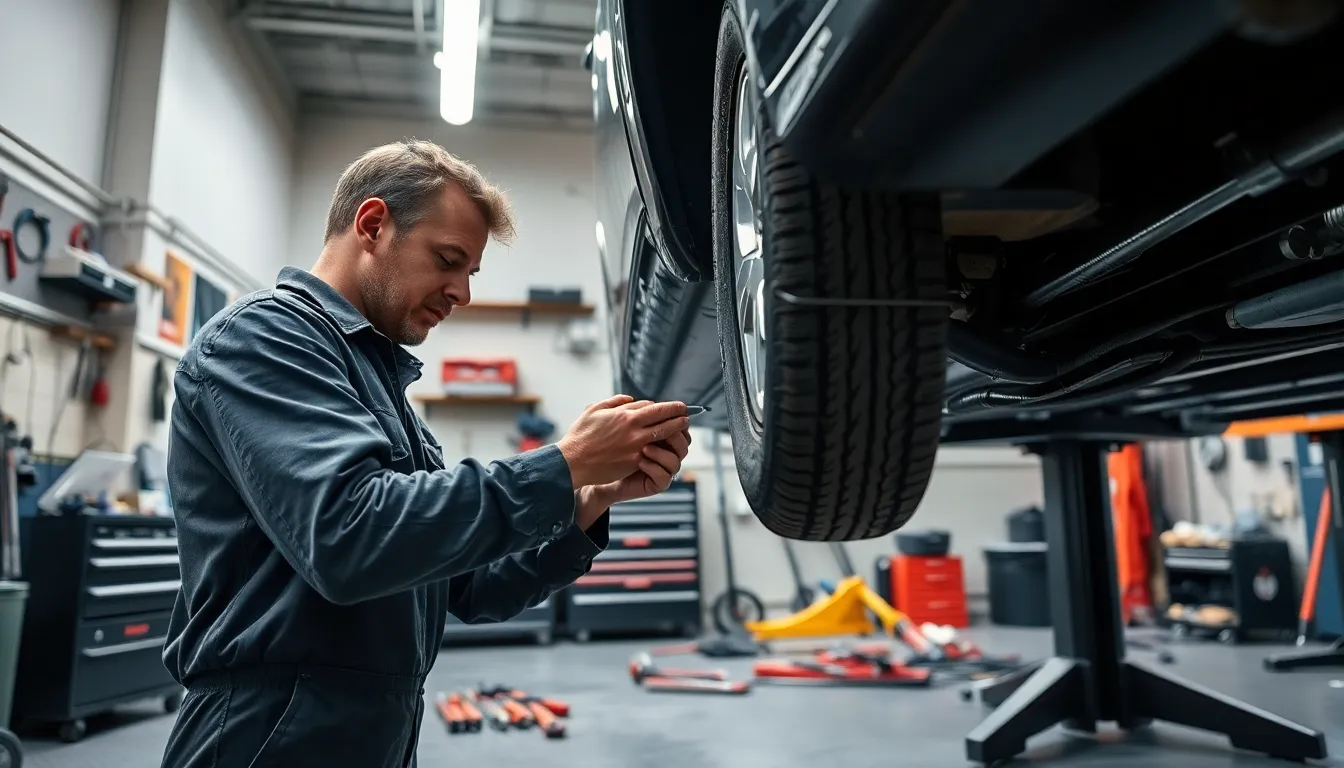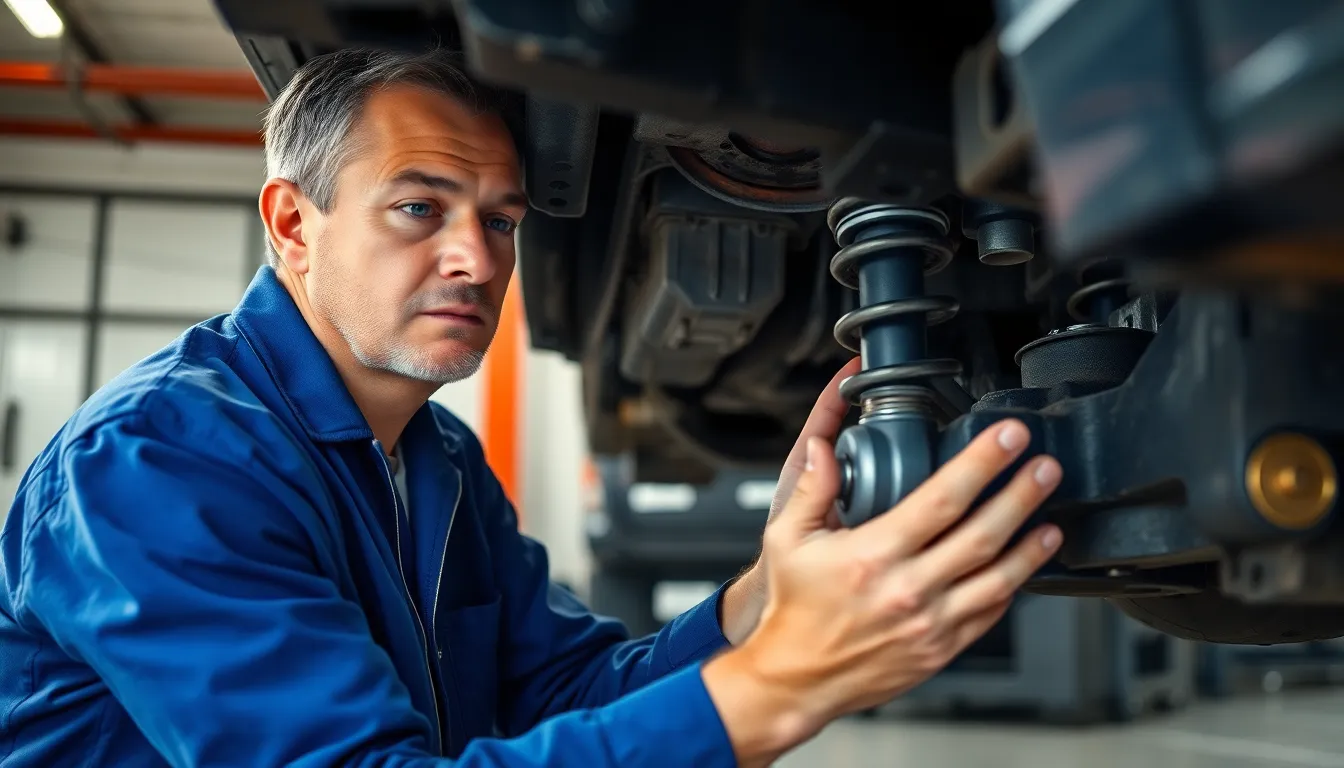Ball joints play a crucial role in a vehicle’s suspension system, connecting the control arms to the steering knuckles. Over time, wear and tear can lead to issues that compromise handling and safety. Understanding the costs associated with replacing ball joints can save car owners both time and money while ensuring their vehicle remains roadworthy.
When considering a ball joint replacement, several factors come into play, including the vehicle make and model, labor costs, and the type of ball joints needed. Prices can vary significantly, making it essential for drivers to be informed. This article explores the typical costs of ball joint replacement, helping car owners make educated decisions about their vehicle maintenance.
Table of Contents
ToggleUnderstanding Ball Joints
Ball joints play a critical role in a vehicle’s suspension system. They connect the control arms to the steering knuckles, allowing for smooth movement and stability while driving.
What Are Ball Joints?
Ball joints are pivot points in a vehicle’s suspension. They consist of a ball-and-socket design that enables smooth movement between the control arms and steering knuckles. Typically, vehicles feature either upper or lower ball joints, and many models include both types. These components can become worn over time, leading to reduced steering control and uneven tire wear.
Importance of Maintaining Ball Joints
Maintaining ball joints is essential for overall vehicle safety and performance. Worn ball joints can cause poor alignment, affecting handling and ride quality. Additionally, they may lead to increased tire wear, which necessitates more frequent replacements. Regular inspection and timely replacement of ball joints help ensure optimal vehicle performance and enhance drivers’ safety on the road.
Signs You Need to Replace Ball Joints


Recognizing the signs of worn ball joints is crucial for vehicle safety and performance. Here are key indicators to monitor.
Warning Signs to Look For
- Unusual Tire Wear: Even tire wear indicates healthy ball joints, while uneven patterns suggest deterioration.
- Steering Wheel Vibration: Excessive vibrations during driving often signal compromised ball joints affecting steering stability.
- Clunking Noises: Hearing clunks or pops when turning or navigating bumps indicates potential ball joint failure.
- Difficulty Steering: A noticeable increase in steering resistance suggests wear, making precise turns challenging.
- Vehicle Alignment Issues: Frequent misalignment requires investigation, as worn ball joints can cause steering misalignment.
- Visible Damage: Inspecting ball joints for grease leaks or physical wear suggests immediate replacement.
Effects of Worn Ball Joints on Vehicle Performance
- Poor Handling: Worn ball joints significantly compromise a vehicle’s handling, leading to a decrease in driver control.
- Increased Tire Wear: Lack of proper support due to worn ball joints accelerates uneven tire wear, necessitating sooner replacements.
- Reduced Suspension Effectiveness: The inability of suspension to function properly results in discomfort during rides over uneven surfaces.
- Impact on Braking: Compromised ball joints can affect braking performance, increasing stopping distances and reducing safety.
- Early Component Failure: Worn ball joints strain surrounding components like control arms and struts, leading to premature failure of those parts.
Monitoring these signs ensures timely intervention and helps maintain optimal vehicle performance.
Factors Affecting Replacement Cost
Multiple factors influence the cost of ball joint replacement, including the vehicle’s specifics and labor requirements. Understanding these variables helps car owners anticipate expenses and make informed decisions.
Average Cost of Ball Joint Replacement
The average cost of ball joint replacement typically ranges between $300 to $1,200. Prices may vary based on the vehicle’s make and model, as certain cars require specialized parts or more extensive labor. For example, high-end vehicles or older models may incur higher costs due to the rarity of parts or additional modifications needed. Always consider obtaining quotes from several mechanics to get an accurate estimate.
Labor vs. Parts Costs
Labor costs often make up a significant portion of the total replacement expense. Labor rates generally range from $75 to $150 per hour, depending on the shop’s location and expertise. Part prices vary; standard ball joints may cost between $50 to $150 each, while premium or vehicle-specific options can reach $300 or more. Keeping these costs in mind allows vehicle owners to budget effectively for the necessary repairs.
DIY vs. Professional Replacement
Choosing between DIY and professional replacement hinges on skill level, available tools, and comfort with vehicle repairs. Each option presents distinct advantages and challenges.
Pros and Cons of DIY Replacement
Pros:
- Cost Savings: DIY replacement reduces labor costs, making it a budget-friendly option.
- Skill Development: DIY projects enhance mechanical skills, providing valuable knowledge for future repairs.
- Flexibility: DIY offers the freedom to work at one’s own pace without appointment constraints.
Cons:
- Complexity: Some vehicles may have intricate designs, making DIY replacement challenging.
- Time Investment: DIY repairs can be time-consuming, potentially leading to extended vehicle downtime.
- Quality Concerns: Inexperienced individuals may not achieve the same quality of work as professionals, risking improper installation.
When to Seek Professional Help
Certain situations warrant professional intervention for ball joint replacement.
- Lack of Experience: Individuals unfamiliar with suspension systems should consult a mechanic to avoid mistakes.
- Specialized Equipment Required: Some vehicles may require specific tools or equipment that DIYers may not possess.
- Time Constraints: When time is limited, a professional can expedite the replacement process effectively.
- Safety Concerns: If any doubts about capability arise, seeking professional help ensures the vehicle’s safety and performance.
Understanding the importance of ball joints and their impact on vehicle safety is crucial for every car owner. Regular inspections and timely replacements can prevent costly repairs down the line and ensure a smoother driving experience. By being aware of the signs of wear and the associated costs of replacement, drivers can make informed decisions that enhance their vehicle’s performance. Whether opting for a DIY approach or seeking professional assistance, prioritizing ball joint maintenance is key to maintaining overall vehicle health and safety on the road.









